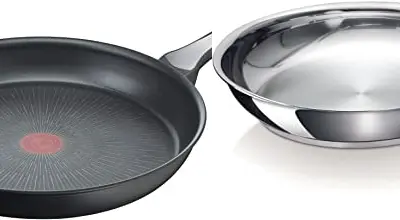This site uses only a few technical cookies necessary for its operation. By continuing to browse, you accept their use.
To find out more...
To find out more...
The two frying pans
You probably have one at home, a non-stick frying pan or saucepan, which everyone calls "Tefal".
But, the risk being known, we have to admit that cooking with it is rather nice, it doesn't stick, and it is easy to sauté something inside.
Yes, because for this kind of recipe, on the contrary, you want it to stick, a little, so that a lot of cooking juices are formed, juices that you can then "deglaze" (some say "decook") by pouring a little liquid in the pan and scraping the bottom and reducing.
You will have understood that for this kind of cooking, the non-stick frying pan is not well suited, you need a classic one, almost old-fashioned, in stainless steel if possible, a bit like this:
This type of pan is ideal for making post-cooking sauces after a meat as mentioned, but also a fish, scallops etc. etc.
On the other hand, to make an omelette in it, you really need to load it with butter or oil, so as not to have to remove the omelette with a chisel and hammer at the end of cooking...
As always with kitchen equipment, you have to pay the price, if you have to buy a second pan, get one made of stainless steel with a thick bottom, why not a French brand, we can find here high quality brands (De Buyer for example), certainly a little more expensive but "the price is forgotten, the quality remains" (my favorite mantra)
I would like to recommend them to you.
To sum up: If possible, have 2 pans at home, one non-stick (ceramic if possible) for everyday cooking, and another steel (stainless if possible) for cooking that requires the formation of juices, for tasty sauces after cooking.
The non-stick pan
Very recognizable by its black color, and its very particular interior coating, the food adheres to it very little, which is infinitely practical for anything that needs to cook without sticking, an omelette for example, but this is the case most of the time.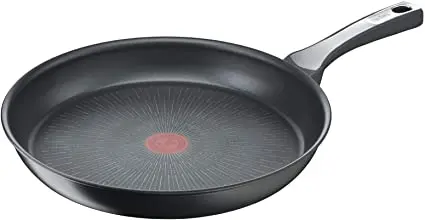
But, the risk being known, we have to admit that cooking with it is rather nice, it doesn't stick, and it is easy to sauté something inside.
But?
There is a downside, it doesn't stick, very good for fried eggs, but for a meat for example, with which you want to make a sauce or a juice after cooking, you will need the cooking juices, and with a non-stick, there is (almost) none... It is normal at the same time, as the meat does not stick, the cooking juices do not form, the famous Maillard reactions, if you want to add cream and Roquefort for a delicious Roquefort sauce for example, it will not be so successful.Yes, because for this kind of recipe, on the contrary, you want it to stick, a little, so that a lot of cooking juices are formed, juices that you can then "deglaze" (some say "decook") by pouring a little liquid in the pan and scraping the bottom and reducing.
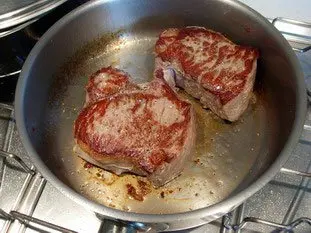
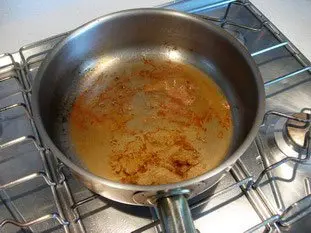
You will have understood that for this kind of cooking, the non-stick frying pan is not well suited, you need a classic one, almost old-fashioned, in stainless steel if possible, a bit like this:
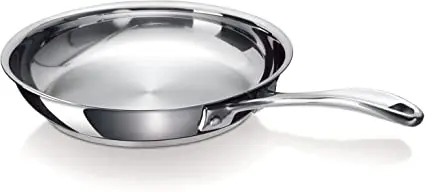
This type of pan is ideal for making post-cooking sauces after a meat as mentioned, but also a fish, scallops etc. etc.
On the other hand, to make an omelette in it, you really need to load it with butter or oil, so as not to have to remove the omelette with a chisel and hammer at the end of cooking...
Not one, but two!
Which means that in the end, you'd better have 2 pans, one non-stick for everyday cooking, and another steel one, for all the cooking that requires juices for after or during the cooking.As always with kitchen equipment, you have to pay the price, if you have to buy a second pan, get one made of stainless steel with a thick bottom, why not a French brand, we can find here high quality brands (De Buyer for example), certainly a little more expensive but "the price is forgotten, the quality remains" (my favorite mantra)
The new generation of non-stick pansI
I'll end by coming back to the non-stick pans, the manufacturers, Tefal being the first, are finally becoming sensitive to the arguments of the consumers who don't want any more dubious products for their health, such as teflon (see the movie "Dark waters" that you may have already seen), teflon that they are progressively starting to abandon. So we have been seeing for some time now so-called non-stick pans appearing, but of a rather light color, where teflon is replaced by ceramic, completely neutral and much more solid.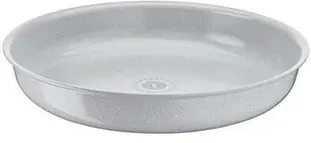
I would like to recommend them to you.
To sum up: If possible, have 2 pans at home, one non-stick (ceramic if possible) for everyday cooking, and another steel (stainless if possible) for cooking that requires the formation of juices, for tasty sauces after cooking.
Lasts posts
Butter vs. grease
We often read in a recipe where a pastry is put into a mould that, just before pouring, the mould should be buttered or greased. But what's the difference between these 2 terms?December 1st 20259665
Getting out of the fridge early
Very often when you're cooking, you need to take food or preparations out of the fridge, to use them in the recipe in progress. There's nothing tricky about this: you just take them out of the fridge and use them, usually immediately, in the recipe. But is this really a good method?November 24th 20251,0975
Who's making the croissants?
When you look at a bakery from the outside, you naturally think that in the bakery, the bakers make the bread, and in the laboratory, the pastry chefs make the cakes. It's very often like that, with each of these professions having quite different ways of working, but sometimes there's also one...November 23th 2025992
Oven height
When we put a dish or cake in the oven, we naturally tend to put it on the middle shelf, and that's what we usually do. But in some cases, this position and height can be a little tricky, so let's find out why.October 8th 20252,7165
The importance of sieving
In recipes that use a fine powder (flour, powdered sugar, etc.), you'll often see the advice to sift before using it. To sift is to pass the powder in question through a sieve (a very fine strainer) before incorporating it into your recipe. It's often advice, but is it really useful?September 3rd 20257,5233
Other pages you may also like
The bitterness of endives
As I write these lines, we are entering the endive season, and if you like it, it's time to enjoy it, if possible with your local producers. Endive is good, but the reproach that is often made of it, and children in particular, is: "It's bitter! And it is (somewhat) true of course, endives...February 9th 201914 K4.9
Raising (or leavening) agents
When we want to make a dough or batter rise when baking, either in patisserie or bread-making, we need to use a raising agent or leavening agent, one of which is called leaven. In the context of baking, a raising agent is simply what "makes something rise". It is a substance which, when added to...June 16th 202157 K4.8
What is the difference between bakery and patisserie?
This is a question that you may well have asked yourself and which I will attempt to answer. In France the two trades of "boulangerie" (bakery) and "pâtisserie" (patisserie and confectionery) have always been quite distinct, but where exactly do the boundaries lie? .February 7th 2017134 K 14.1
Cooking time for pasta
What is as good and simple as pasta? Not much, I think, and it's so easy to prepare: boiling water, salted (or not, depending on your taste), a few minutes of boiling and it's ready. The only "difficulty", so to speak, is the respect of the cooking time and the risk of, unfortunately, overcooking...July 18th 201924 K4.6
Cleaning endives
If you buy your endives elsewhere than in supermarkets, and in this case the best is of course from a market gardener, he or she is the one who planted and harvested them, in this case you will have endives full of earth or sand, depending on where they were grown, which is normal and reassuring, we...March 24th 202026 K4.6
Post a comment or question
Follow this page
If you are interested in this page, you can "follow" it, by entering your email address here. You will then receive a notification immediately each time the page is modified or a new comment is added. Please note that you will need to confirm this following.
Note: We'll never share your e-mail address with anyone else.
Alternatively: you can subscribe to the mailing list of cooling-ez.com , you will receive a e-mail for each new recipe published on the site.
